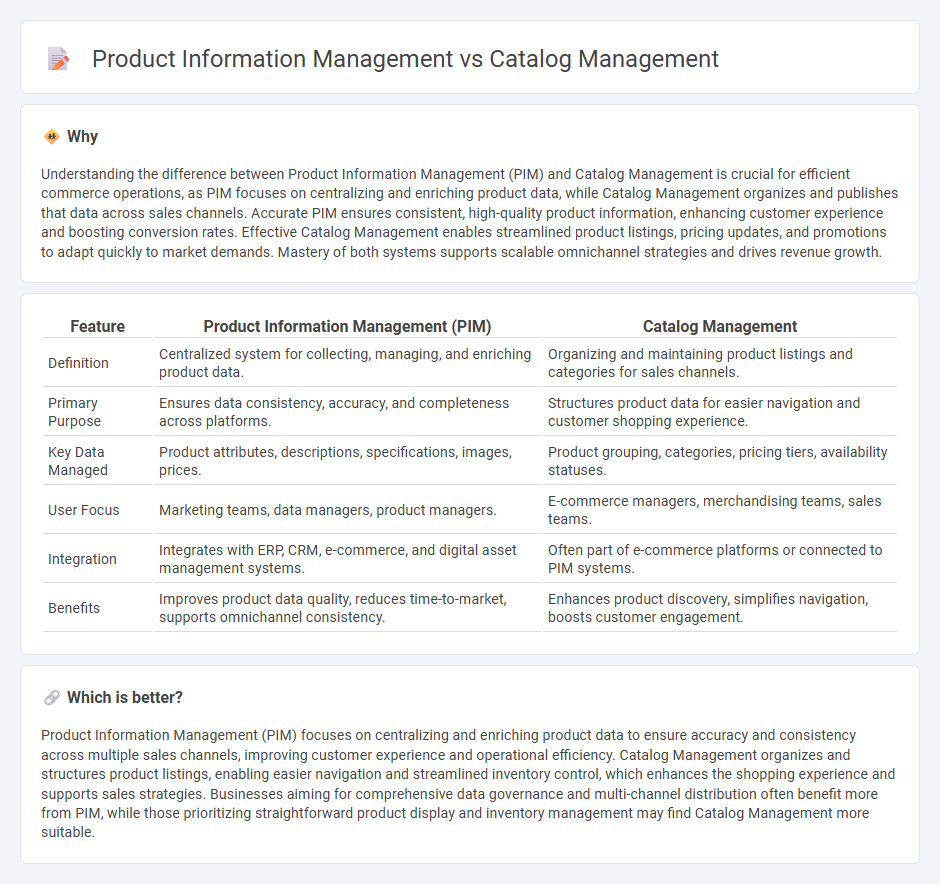
Product information management (PIM) focuses on centralizing and optimizing detailed product data such as descriptions, specifications, and digital assets to ensure accuracy and consistency across channels. Catalog management organizes and structures this product information into categories, pricing, and inventory for easier navigation and streamlined customer experiences in e-commerce platforms. Explore deeper to understand how both systems enhance operational efficiency and sales performance.
Why it is important
Understanding the difference between Product Information Management (PIM) and Catalog Management is crucial for efficient commerce operations, as PIM focuses on centralizing and enriching product data, while Catalog Management organizes and publishes that data across sales channels. Accurate PIM ensures consistent, high-quality product information, enhancing customer experience and boosting conversion rates. Effective Catalog Management enables streamlined product listings, pricing updates, and promotions to adapt quickly to market demands. Mastery of both systems supports scalable omnichannel strategies and drives revenue growth.
Comparison Table
| Feature | Product Information Management (PIM) | Catalog Management |
|---|---|---|
| Definition | Centralized system for collecting, managing, and enriching product data. | Organizing and maintaining product listings and categories for sales channels. |
| Primary Purpose | Ensures data consistency, accuracy, and completeness across platforms. | Structures product data for easier navigation and customer shopping experience. |
| Key Data Managed | Product attributes, descriptions, specifications, images, prices. | Product grouping, categories, pricing tiers, availability statuses. |
| User Focus | Marketing teams, data managers, product managers. | E-commerce managers, merchandising teams, sales teams. |
| Integration | Integrates with ERP, CRM, e-commerce, and digital asset management systems. | Often part of e-commerce platforms or connected to PIM systems. |
| Benefits | Improves product data quality, reduces time-to-market, supports omnichannel consistency. | Enhances product discovery, simplifies navigation, boosts customer engagement. |
Which is better?
Product Information Management (PIM) focuses on centralizing and enriching product data to ensure accuracy and consistency across multiple sales channels, improving customer experience and operational efficiency. Catalog Management organizes and structures product listings, enabling easier navigation and streamlined inventory control, which enhances the shopping experience and supports sales strategies. Businesses aiming for comprehensive data governance and multi-channel distribution often benefit more from PIM, while those prioritizing straightforward product display and inventory management may find Catalog Management more suitable.
Connection
Product information management (PIM) centralizes and organizes detailed product data, ensuring accuracy and consistency across all sales channels. Catalog management utilizes this structured information to create, maintain, and distribute comprehensive product catalogs tailored for various markets and platforms. Together, they streamline product data flow, enhance customer experience, and improve inventory visibility in commerce operations.
Key Terms
Centralized Data Repository
Catalog management and product information management (PIM) both rely on a centralized data repository to streamline product data handling and ensure consistency across channels. While catalog management focuses on organizing product categories, pricing, and promotions, PIM emphasizes comprehensive enrichment, accuracy, and integration of detailed product attributes and metadata. Explore how leveraging a centralized data repository can optimize your product data strategy and enhance operational efficiency.
Product Listings
Product Listings play a critical role in both Catalog Management and Product Information Management (PIM), yet their focus and scope differ significantly. Catalog Management specializes in organizing product data to optimize sales channels, emphasizing SKU grouping, pricing, and category hierarchies, while PIM focuses on enriching detailed product attributes, digital assets, and ensuring data consistency across multiple platforms. Explore how integrating both approaches can elevate your product listing strategy by visiting our detailed guide.
Data Syndication
Catalog management centralizes and organizes product listings, streamlining item categorization and pricing updates across sales channels. Product information management (PIM) emphasizes comprehensive data enrichment, quality control, and integration from multiple sources to ensure consistent, accurate product content. Explore how data syndication optimizes both systems by automating seamless distribution of standardized product data to various platforms and partners.
Source and External Links
Catalog Management - Salsify - Catalog management is the process of organizing, aggregating, updating, and managing product data to create seamless workflows with partners, ensuring accurate and consistent product information across all sales channels through tools like product information management (PIM) systems.
Types of Catalog Management (2022 Guide) - Sales Layer Blog - Catalog management involves creating and maintaining product descriptions, setting prices, managing inventory, and structuring product data such as names, SKUs, and categories to optimize omnichannel sales and improve customer experience.
What is Catalog Management? - DealHub - Catalog management is a systematic approach for managing a product library by centralizing product data using PIM systems, tagging and categorizing products, and integrating seamlessly with sales and marketing tools to enhance searchability and sales effectiveness.
 dowidth.com
dowidth.com